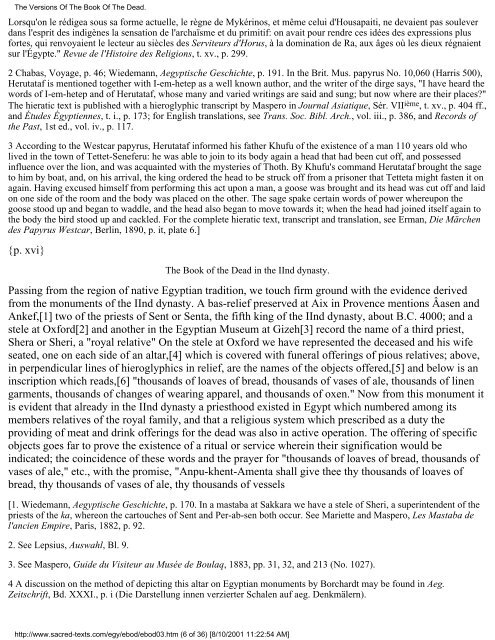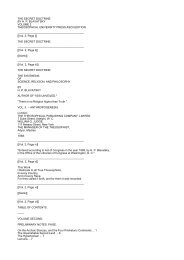Create successful ePaper yourself
Turn your PDF publications into a flip-book with our unique Google optimized e-Paper software.
The Versions Of The <strong>Book</strong> Of The <strong>Dead</strong>.<br />
Lorsqu'on le rédigea sous sa forme actuelle, le règne de Mykérinos, et même celui d'Housapaiti, ne devaient pas soulever<br />
dans l'esprit des indigènes la sensation de l'archaïsme et du primitif: on avait pour rendre ces idées des expressions plus<br />
fortes, qui renvoyaient le lecteur au siècles des Serviteurs d'Horus, à la domination de Ra, aux âges où les dieux régnaient<br />
sur l'Égypte." Revue de l'Histoire des Religions, t. xv., p. 299.<br />
2 Chabas, Voyage, p. 46; Wiedemann, Aegyptische Geschichte, p. 191. In <strong>the</strong> Brit. Mus. papyrus No. 10,060 (Harris 500),<br />
Herutataf is mentioned toge<strong>the</strong>r with I-em-hetep as a well known author, and <strong>the</strong> writer <strong>of</strong> <strong>the</strong> dirge says, "I have heard <strong>the</strong><br />
words <strong>of</strong> I-em-hetep and <strong>of</strong> Herutataf, whose many and varied writings are said and sung; but now where are <strong>the</strong>ir places?"<br />
The hieratic text is published with a hieroglyphic transcript by Maspero in Journal Asiatique, Sér. VII ième , t. xv., p. 404 ff.,<br />
and Études Égyptiennes, t. i., p. 173; for English translations, see Trans. Soc. Bibl. Arch., vol. iii., p. 386, and Records <strong>of</strong><br />
<strong>the</strong> Past, 1st ed., vol. iv., p. 117.<br />
3 According to <strong>the</strong> Westcar papyrus, Herutataf informed his fa<strong>the</strong>r Khufu <strong>of</strong> <strong>the</strong> existence <strong>of</strong> a man 110 years old who<br />
lived in <strong>the</strong> town <strong>of</strong> Tettet-Seneferu: he was able to join to its body again a head that had been cut <strong>of</strong>f, and possessed<br />
influence over <strong>the</strong> lion, and was acquainted with <strong>the</strong> mysteries <strong>of</strong> Thoth. By Khufu's command Herutataf brought <strong>the</strong> sage<br />
to him by boat, and, on his arrival, <strong>the</strong> king ordered <strong>the</strong> head to be struck <strong>of</strong>f from a prisoner that Tetteta might fasten it on<br />
again. Having excused himself from performing this act upon a man, a goose was brought and its head was cut <strong>of</strong>f and laid<br />
on one side <strong>of</strong> <strong>the</strong> room and <strong>the</strong> body was placed on <strong>the</strong> o<strong>the</strong>r. The sage spake certain words <strong>of</strong> power whereupon <strong>the</strong><br />
goose stood up and began to waddle, and <strong>the</strong> head also began to move towards it; when <strong>the</strong> head had joined itself again to<br />
<strong>the</strong> body <strong>the</strong> bird stood up and cackled. For <strong>the</strong> complete hieratic text, transcript and translation, see Erman, Die Märchen<br />
des Papyrus Westcar, Berlin, 1890, p. it, plate 6.]<br />
{p. xvi}<br />
The <strong>Book</strong> <strong>of</strong> <strong>the</strong> <strong>Dead</strong> in <strong>the</strong> IInd dynasty.<br />
Passing from <strong>the</strong> region <strong>of</strong> native Egyptian tradition, we touch firm ground with <strong>the</strong> evidence derived<br />
from <strong>the</strong> monuments <strong>of</strong> <strong>the</strong> IInd dynasty. A bas-relief preserved at Aix in Provence mentions Âasen and<br />
Ankef,[1] two <strong>of</strong> <strong>the</strong> priests <strong>of</strong> Sent or Senta, <strong>the</strong> fifth king <strong>of</strong> <strong>the</strong> IInd dynasty, about B.C. 4000; and a<br />
stele at Oxford[2] and ano<strong>the</strong>r in <strong>the</strong> Egyptian Museum at Gizeh[3] record <strong>the</strong> name <strong>of</strong> a third priest,<br />
Shera or Sheri, a "royal relative" On <strong>the</strong> stele at Oxford we have represented <strong>the</strong> deceased and his wife<br />
seated, one on each side <strong>of</strong> an altar,[4] which is covered with funeral <strong>of</strong>ferings <strong>of</strong> pious relatives; above,<br />
in perpendicular lines <strong>of</strong> hieroglyphics in relief, are <strong>the</strong> names <strong>of</strong> <strong>the</strong> objects <strong>of</strong>fered,[5] and below is an<br />
inscription which reads,[6] "thousands <strong>of</strong> loaves <strong>of</strong> bread, thousands <strong>of</strong> vases <strong>of</strong> ale, thousands <strong>of</strong> linen<br />
garments, thousands <strong>of</strong> changes <strong>of</strong> wearing apparel, and thousands <strong>of</strong> oxen." Now from this monument it<br />
is evident that already in <strong>the</strong> IInd dynasty a priesthood existed in Egypt which numbered among its<br />
members relatives <strong>of</strong> <strong>the</strong> royal family, and that a religious system which prescribed as a duty <strong>the</strong><br />
providing <strong>of</strong> meat and drink <strong>of</strong>ferings for <strong>the</strong> dead was also in active operation. The <strong>of</strong>fering <strong>of</strong> specific<br />
objects goes far to prove <strong>the</strong> existence <strong>of</strong> a ritual or service wherein <strong>the</strong>ir signification would be<br />
indicated; <strong>the</strong> coincidence <strong>of</strong> <strong>the</strong>se words and <strong>the</strong> prayer for "thousands <strong>of</strong> loaves <strong>of</strong> bread, thousands <strong>of</strong><br />
vases <strong>of</strong> ale," etc., with <strong>the</strong> promise, "Anpu-khent-Amenta shall give <strong>the</strong>e thy thousands <strong>of</strong> loaves <strong>of</strong><br />
bread, thy thousands <strong>of</strong> vases <strong>of</strong> ale, thy thousands <strong>of</strong> vessels<br />
[1. Wiedemann, Aegyptische Geschichte, p. 170. In a mastaba at Sakkara we have a stele <strong>of</strong> Sheri, a superintendent <strong>of</strong> <strong>the</strong><br />
priests <strong>of</strong> <strong>the</strong> ka, whereon <strong>the</strong> cartouches <strong>of</strong> Sent and Per-ab-sen both occur. See Mariette and Maspero, Les Mastaba de<br />
l'ancien Empire, Paris, 1882, p. 92.<br />
2. See Lepsius, Auswahl, Bl. 9.<br />
3. See Maspero, Guide du Visiteur au Musée de Boulaq, 1883, pp. 31, 32, and 213 (No. 1027).<br />
4 A discussion on <strong>the</strong> method <strong>of</strong> depicting this altar on Egyptian monuments by Borchardt may be found in Aeg.<br />
Zeitschrift, Bd. XXXI., p. i (Die Darstellung innen verzierter Schalen auf aeg. Denkmälern).<br />
http://www.sacred-texts.com/egy/ebod/ebod03.htm (6 <strong>of</strong> 36) [8/10/2001 11:22:54 AM]

















